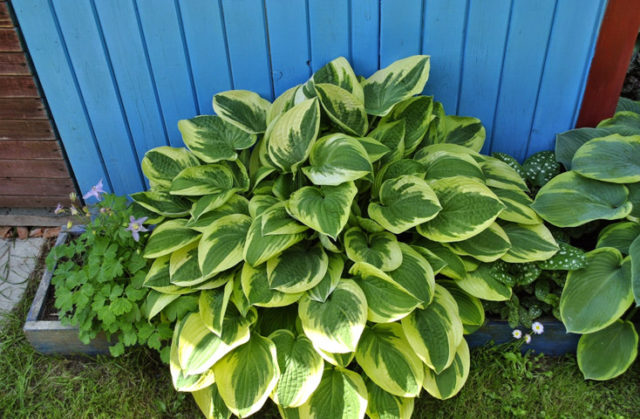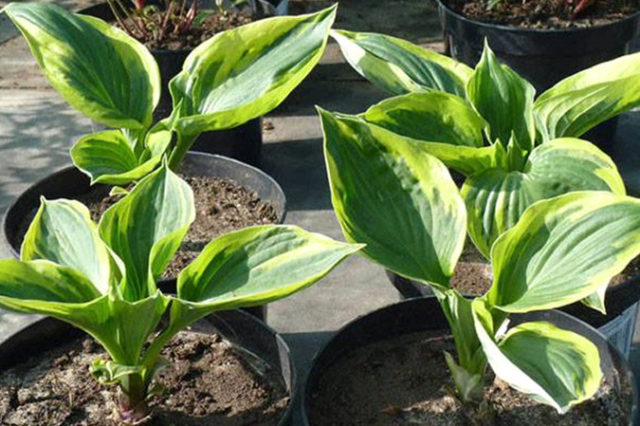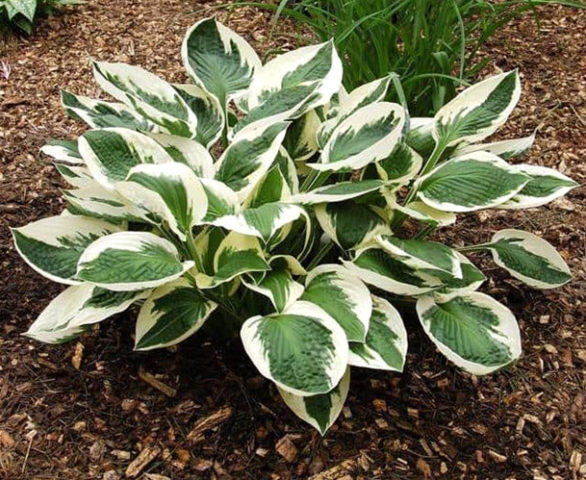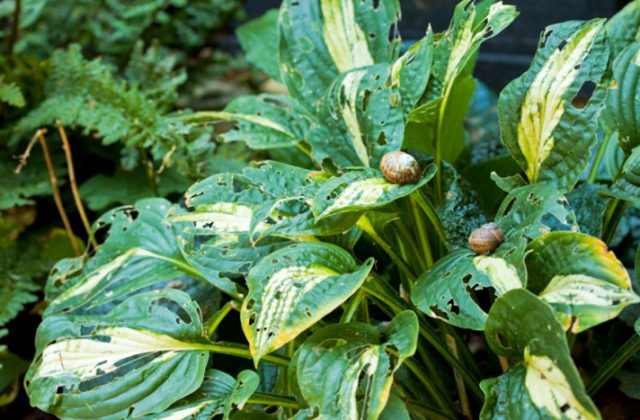Content
Hosta Brim Cap is notable for its large cupped leaves with a light pattern along the edges. She is able to fill the garden with greenery and decorate the landscape of the site. The plant is easy to care for and does not need to have super fertile soil for good growth and development. The Asian hybrid multiplies in several ways and after three seasons develops into a full-fledged plant.
Description of Brim Cap hosts
"Brim Cup" or "variegated bowl" is one of the exotic hosta varieties. The plant has unusual leaves that resemble containers in shape. Hosta plates have a rich green color with a light, golden edging. The central part is ahead of the growth of the edge, so the leaves become shriveled. Towards the middle of summer, the edges change from a light shade to white.
The flower is distinguished by earlier flowering. The Brim Cup opens in late June or early July. Brush-shaped inflorescences appear on a bare stem. The height of the peduncle can reach 45-50 cm. At the beginning of flowering, they have a lilac hue, then by mid-July they lose their pigment and become white, like the ornament on the leaves. Flowers adorn the garden until August.
An adult shrub reaches a height of 30-35 cm with leaves up to 18 cm long and 16 cm wide. One copy covers an area of up to 75 cm.

Brim Cap hosts bloom in mid-July
Features of the hosta hybrid Brim Cup:
- has an attractive appearance;
- growing rapidly;
- unpretentious in terms of soil composition and care;
- grows well in darkened areas;
- prevents the active growth of weeds;
- grows for a long time in one place;
- does not age;
- withstands low temperatures.
The leaves of an adult plant are rounded and smoother. 8-10-year-old bushes reach the highest flowering.
The cup-shaped hosta belongs to the plants of the third zone of winter hardiness and can withstand temperatures down to -40 ° C.
The homeland of the hosts is Asia. A comfortable climate for these plants prevails in central Russia, where the summer period is characterized by low temperatures and high air humidity.
Application in landscape design
Hosts can be planted along the banks of the reservoir in combination with other representatives of the flora that prefer moist soil.
A chic composition is formed by "Brim Cup" and the white variety "Bressingham Blue".
It is better to plant small plants at some distance from an adult hosta, otherwise its leaves will not allow undersized bushes to develop.

Bushes hosts "Brim Cap" serve as an excellent frame for the garden area
These include:
- primroses;
- daisies;
- lungwort.
Plants with small bulbs that do not need to be dug out after each season are planted next to the hosts.
It can be:
- muscarica;
- crocuses;
- chionodox;
- Pushkinia;
- daffodils.
Breeding methods
The host can reproduce in three ways:
- using seeds;
- cuttings;
- division of a mature bush.
The third method is the most popular among gardeners.
"Brim Cup" tolerates division and carrying well, takes root quickly. It is necessary to divide the adult bush with a shovel and transfer the process with part of the rhizome to a separate hole.
Landing algorithm
You can plant new plants in early spring, before the leaves appear, or in late summer - early autumn.
Warning! The choice of Brim Cap bushes for planting must be approached carefully. There should be several buds in the rhizome zone, which have just begun to germinate.
The roots of healthy hosta seedlings are spreading, not shriveled. Their length is about 10 cm. The specimens on which there is mold or decay are not suitable for planting.
It is important to organize the correct storage of young cuttings before planting in the ground. It can be a room with a low temperature (up to + 10 ° С), away from sunlight.
Can be stored in places:
- cellar;
- refrigerator (bottom shelf);
- warm balcony.

Seedlings that take root and grow stronger before the frost begins to winter better
The hosta hybrid Brim Cup is a perennial plant and should be rooted thoroughly.
As fertilizers that are applied to the planting site, you can use:
- compost;
- rotted manure;
- peat;
- river sand;
- ash (if acidic soil prevails in the garden).
Fertilizers need to be mixed and filled with this mixture. The well should be 2/3 full. Then the soil should be watered abundantly with cold water and mixed with nutritious soil.
The roots should be spread over a fertilized layer of soil. Germinating buds on the root collar must be placed at least below the soil level. Next, you need to cover the roots with earth and re-moisten the soil. Mulching around the plantings.
Growing rules
"Brim Cup" grows well with regular moderate watering, but not in swampy soils, it feels great in the darkened areas of the site and away from strong gusts of wind and drafts.
If the hosta grows in a sunny area of the garden, it is better to plant a plant with a lush crown in front of it, which needs more ultraviolet radiation.
The degree of illumination required for the full-fledged growth of the Brim Cap hybrid can be determined by the edging of its leaf plates: the more area the light pattern occupies, the more light the host needs.
A deep dark green hue indicates that the shrub will feel more comfortable in shady areas.

Brim Cap grows well in moist, slightly acidic soils
The best watering method is drip. The host should be provided with moisture without touching the leaves. With proper watering, the sun's rays will not burn greenery and fungus will not spread.
The hybrid does not need frequent abundant feeding. You need to fertilize the bushes 2-3 times per season or apply fertilizers that provide an effect for a long time.
You can feed Brim Cup with a combined mineral composition in early spring.
The growth and development of hosts is positively influenced by nitrogen, phosphorus and potassium compositions.
Algorithm:
- At the beginning of the season, when the leaves have not yet "hatched", the host "Brim Cap" is fertilized with a complex with a high nitrogen content. The optimal proportions of N + P + K substances are 20:10:10. You can add azophoska. When using mineral mixtures, it is important not to overdo it.
- In spring and summer, for the best color of the foliage, you need to apply fertilizers with an optimal ratio of all components.
- The plantings benefit from organic compounds: humus, manure. They are safe, but the color of the leaf blades can vary.
The mulching method makes the soil moisturized and helps to ventilate the Brim Cup root system. The top layer of the substrate does not dry out and remains loosened.
Types of mulch:
- pieces of bark;
- textile covering;
- coniferous cones and needles.
Preparing for winter
As a preparation of the plant for the winter period, at the end of summer, it is necessary to suspend the feeding of the substrate.
Leaves do not need to be cut off. Due to its high frost resistance, the hosta tolerates well the low temperatures characteristic of the middle zone of the Russian Federation, the Republic of Belarus and Ukraine, even in open ground.

Before winter frosts, you need to suspend plant feeding.
If the underground part of the hosta is close to the surface, it may suffer with frequent temperature changes in winter.
Diseases and pests
Brim Cap hostas are not susceptible to disease, but can be damaged by pests.
The main enemy of the plant is a slug. The appearance of a bush can be spoiled even by one individual, and there are many of them. Slugs eat fresh leaves. There is a simple and gentle way of pest control - mulching. But using soft peat or sawdust will not be effective.
Slugs will not crawl onto high surfaces. Also, the bushes can be sprinkled around with lime or superphosphate fertilizer, pests do not like these substances.
For the Asian hybrid "Brim Cap" these fertilizers are harmless. Lime lowers the percentage of soil acidity, and superphosphate makes its composition richer.
Wood ash, which contains potassium carbonate and alkali, is also effective.

Snails and slugs are removed by hand
Conclusion
Hosta Brim Cap is notable for the beauty of the leaves and the ease of maintenance. The plant is often the object of interest for gardeners and landscape designers. For successful cultivation, you need to choose the right rooting site and water it regularly.
Reviews for host Brim Cap








